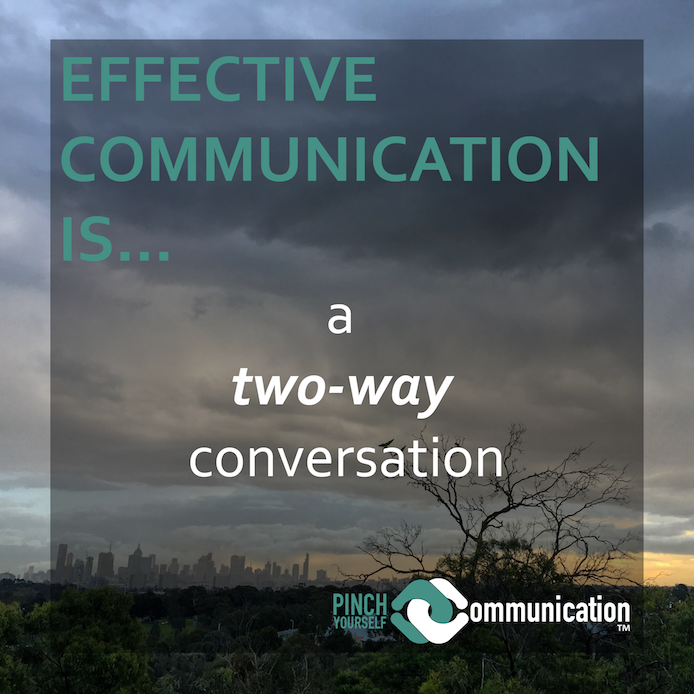Part of the Effective Communication series from Pinch Yourself Communication
There’s something about technology that makes it easy for business people to default to broadcasting messages rather than seeking a conversation.
There is a more effective way to get results from both internal and external communication and we’re going to look at six reasons why two-way conversation should be part of your approach.
Two-way conversation is the oldest form of communication but it’s by no means out of date. At its simplest, it’s a person talking with another person one-to-one.
When the printing press, then radio and television arrived, people were able to communicate one-to-many and suddenly we could broadcast our messages. In times gone by if a business or other leader had information to share, they could broadcast it to the organisation or the outside world. In their eyes, communication delivered.
It’s debatable whether this was ever the right strategy because by definition, communication is about creating shared understanding. How better to know whether this has occurred than by hearing back from the people you’re trying to communicate with?
The broadcast approach also presumes that ‘getting my message out’ is the most important objective, sometimes without priority for building the relationship or creating a sense of connection. As they say about doing business in the island nations of the Pacific, you need some sense of: ‘relationship first, business later.’
Modern communication models, such as the UK employee engagement model Engage for Success, have promoted the use of two-way communication because its recognised that both sharing and listening are required to build relationships, trust and engagement.
However, with social networking tools now at our disposal, it’s not uncommon to see people defaulting to a broadcast approach. This can feel like a safe first step into social forums, but the potential is so much greater.
While face-to-face conversation delivers the strongest connections, the essence of two-way conversation can be achieved regardless of the technology – by phone, email or online.
Social platforms are powerful tools that have enabled conversations to take place – now on a many-to-many basis – on a global scale. Your clients, external stakeholders and your employees share their views and experiences and do business with you as part of networks and communities on social media. In many modern workplaces staff do the same and are able to collaborate and do business via employee social networking (ESN) tools.
However, many-to-many conversation is an extension of two-way conversation not a move away from it.
Here are six reasons to step up your focus on two-way communication:
- Trust. The need for two-way engagement has been heightened by the fact that business and other leaders do not enjoy anywhere near the same level of trust they did in times past – as global trust research by Edelman shows. Two-way conversation is important for building relationships, trust and understanding, and to foster greater employee buy-in and stakeholder satisfaction.
- Cut through.Your genuine efforts to have a two-way conversation will help you cut through the broadcast clutter and give your business a human face. This takes effort but will come from empowering staff and a mindset that considers your network as a community, not an audience, and through seeking to engage and add value.
- Meet stakeholder expectations.The social media era has fostered a stronger culture of participation and people expecting to have their say and get a response. Employees, customers and stakeholders who are critical to your business may also expect to be consulted about changes that will affect them and appreciate the opportunity to influence outcomes.
- Insight. If you’re not creating opportunities for input, feedback, conversation and listening, you’re likely to miss out on valuable insights that might help improve your business. You may not always like what you hear, but at the very least, listening will help you to understand your stakeholders and enable you to communicate more effectively with them. At the other end of the spectrum, responding to stakeholder input may get organisations closer to aspirations for more responsible business decisions and ‘win-win’ outcomes.
- Issues management. Without two-way conversation, you may be missing the opportunity to understand and proactively address an issue before it escalates within your workplace or your community.
- Measurement. Without a two-way approach, you’re almost certainly missing out on a key measure of the outcomes and effectiveness of your communication, marketing and engagement strategy.

What does this all mean for communication?
It doesn’t mean there’s no role for broadcasting announcements. There are plenty of things that warrant making announcements and in some cases, they’re required by law. For example the requirement for listed companies to keep the stock market continuously updated and for government agencies to have some reports tabled in parliament.
It does mean ensuring you’re fostering an ongoing conversation with your staff and stakeholders, and that you consider the role of consultation and participation, particularly when you’re planning significant changes.
For example,
Do your employees have an opportunity to contribute their ideas and concerns?What opportunities, forums and channels are you providing for feedback internally and externally?
How do you plan to consult or involve people in deciding and implementing important changes that impact your staff or stakeholders?
Do you conduct surveys to learn more from your employees and stakeholders about their needs and expectations, and how you’re tracking with them?
Are you getting the right balance between what you broadcast and how you engage in two-way conversation?
What does effective communication mean to you?
Let’s make this a two-way conversation: please share your thoughts and ideas in the comments below



Published by